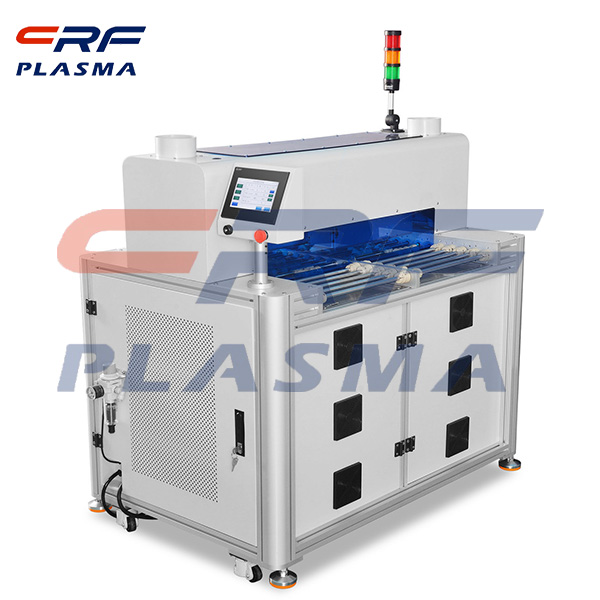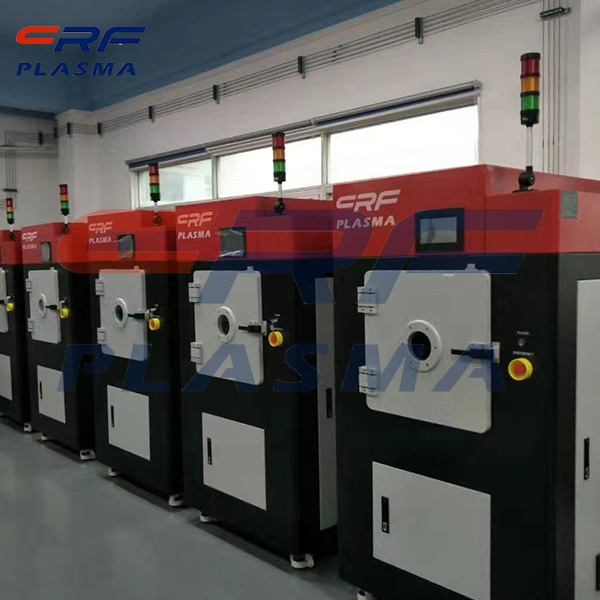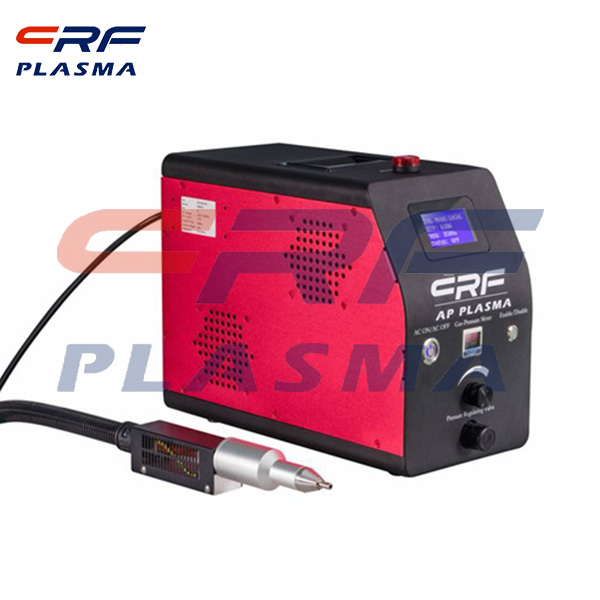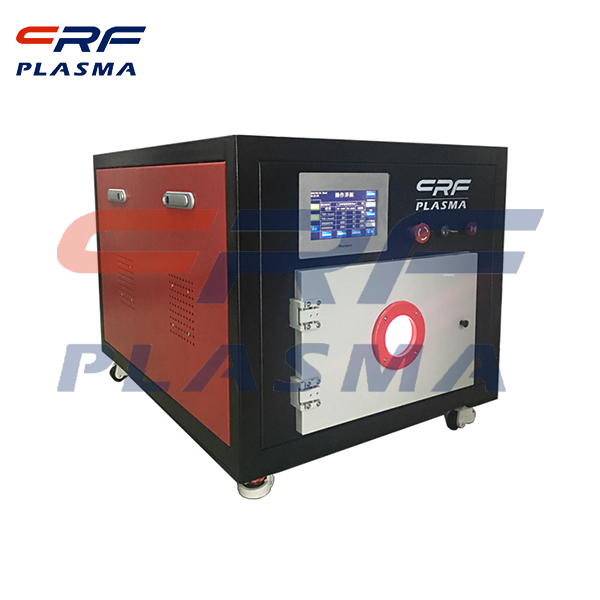
Welcome to Shenzhen Sing Fung Intelligent Manufacturing Co., Ltd.
E-mail:shaobo@sfi-crf.com
Plasma processor green environmental protection process, improve the surface adhesion effect
- Categories:Company Dynamics
- Author:plasma cleaning machine-surface treatment equipment-CRF plasma machine-Sing Fung Intelligent Manufacturing
- Origin:
- Time of issue:2020-09-04
- Views:
(Summary description)Plasma processor green environmental protection process, improve the surface adhesion effect of surface activation treatment device, the role of surface hydrophilic improvement, surface activation and surface modification tools. Plasma treatment can be applied to a wide variety of materials, including metals, ceramics, composites, glass, connectors, plastics, polymers and biomaterials, as well as surfaces of various geometric shapes. Plasma cleaning machine can be widely used in surface engineering applications, including surface cleaning, surface sterilization, surface activation, surface alteration, surface wettability improvement, surface preparation for adhesion and adhesion, surface chemical modification and surface treatment. Polymers and biomaterials are surface etched and surface activated by activation, grafting and surface coating. Conventional cleaning methods do not remove the film from the surface of the material, leaving a very thin layer of impurities, and solvent cleaning is a typical example of this. The plasma cleaning machine is used to gently and cleanly scrub the surface of a material by bombarding it with plasma. Plasma cleaning will remove invisible oil film, tiny rusts and other contaminants that form on the surface as a result of user contact with outdoor exposure, etc. Moreover, plasma cleaning will leave no residue on the surface. The advantage of plasma cleaning machine is that it can not only clean the dirt on the surface, but also enhance the adhesion of the material surface. For example, the following Polymer cleaning: 1. Surface cleaning of polymer Plasma ablation mechanically removes contaminants by bombarding the surface with high-energy electrons and ions. Plasma surface cleaning removes contaminants that may be present in some processed polymers, unwanted polymer surface coatings, and weak boundary layers. 2. Surface recombination of polymers Inert gases used in plasma ablation break the chemical bonds on the polymer surface leading to the formation of free functional groups on the polymer surface. Free functional groups on the polymer surface rebond to form the original polymer structure, and can also bond to adjacent free functional groups on the same polymer chain, or chain to nearby free functional groups on different polymer chains. Polymer surface structure recombination can improve surface hardness and chemical resistance. 3. Surface modification of polymers Plasma ablation destroys the chemical bonds on the polymer surface, which leads to the formation of free functional groups on the polymer surface. Based on the chemical properties of plasma process gases, these surface free functional groups are connected with atoms or chemical groups in the plasma to form new polymer functional groups, replacing the old surface polymer functional groups. Polymer surface modification can change the chemical properties of the material surface, but the overall properties of the material do not change. 4. Surface coating of polymer Plasma coating is a thin layer of plasma coating formed on the surface of the substrate by the process of gas polymerization. If the production gases used are composed of complex molecules, such as methane, tetraffluorides, and carbon, they will break apart in the plasma to form free functional monomers, which will bond and recombine on the polymer surface to coat the film. The polymer surface coating can significantly change the surface permeability and friction. Ii. Biomaterials 1. Disinfection and sterilization: Plasma disinfection has gained a lot of recognition in the disinfection and sterilization of medical equipment. Plasma treatment has great potential in synchronous cleaning and disinfection of medical devices. Plasma disinfection sterilization is especially suitable for high temperature, chemicals, irradiation, allergic medical appliances or dental implants and equipment cleaning. 2. Improvement of adhesion force Many biomaterials have low surface energy, which makes it difficult to adhere and coat them effectively. Plasma surface activation leads to the formation of surface functional groups that will enhance the surface energy of biomaterials and improve the adhesion of interfaces. 3. Invasive Most untreated biomaterials have very weak wettability (hydrophilicity). Plasma surface treatment can increase or decrease the hydrophilicity of many different biomaterials. Through plasma activation can make the surface hydrophilic, through plasma coating film, can make the surface hydrophobic. 4. Low friction and barrier layers Some materials have high friction coefficients on ester and polymer surfaces, such as polyurethane. Plasma coating has a small friction coefficient, which makes the surface of biomaterial smoother. Plasma coatings can also form a dense barrier layer to reduce the permeability of the liquid or ga
Plasma processor green environmental protection process, improve the surface adhesion effect
(Summary description)Plasma processor green environmental protection process, improve the surface adhesion effect of surface activation treatment device, the role of surface hydrophilic improvement, surface activation and surface modification tools. Plasma treatment can be applied to a wide variety of materials, including metals, ceramics, composites, glass, connectors, plastics, polymers and biomaterials, as well as surfaces of various geometric shapes.
Plasma cleaning machine can be widely used in surface engineering applications, including surface cleaning, surface sterilization, surface activation, surface alteration, surface wettability improvement, surface preparation for adhesion and adhesion, surface chemical modification and surface treatment. Polymers and biomaterials are surface etched and surface activated by activation, grafting and surface coating.
Conventional cleaning methods do not remove the film from the surface of the material, leaving a very thin layer of impurities, and solvent cleaning is a typical example of this.
The plasma cleaning machine is used to gently and cleanly scrub the surface of a material by bombarding it with plasma.
Plasma cleaning will remove invisible oil film, tiny rusts and other contaminants that form on the surface as a result of user contact with outdoor exposure, etc. Moreover, plasma cleaning will leave no residue on the surface.
The advantage of plasma cleaning machine is that it can not only clean the dirt on the surface, but also enhance the adhesion of the material surface.
For example, the following
Polymer cleaning:
1. Surface cleaning of polymer
Plasma ablation mechanically removes contaminants by bombarding the surface with high-energy electrons and ions.
Plasma surface cleaning removes contaminants that may be present in some processed polymers, unwanted polymer surface coatings, and weak boundary layers.
2. Surface recombination of polymers
Inert gases used in plasma ablation break the chemical bonds on the polymer surface leading to the formation of free functional groups on the polymer surface.
Free functional groups on the polymer surface rebond to form the original polymer structure, and can also bond to adjacent free functional groups on the same polymer chain, or chain to nearby free functional groups on different polymer chains.
Polymer surface structure recombination can improve surface hardness and chemical resistance.
3. Surface modification of polymers
Plasma ablation destroys the chemical bonds on the polymer surface, which leads to the formation of free functional groups on the polymer surface.
Based on the chemical properties of plasma process gases, these surface free functional groups are connected with atoms or chemical groups in the plasma to form new polymer functional groups, replacing the old surface polymer functional groups.
Polymer surface modification can change the chemical properties of the material surface, but the overall properties of the material do not change.
4. Surface coating of polymer
Plasma coating is a thin layer of plasma coating formed on the surface of the substrate by the process of gas polymerization.
If the production gases used are composed of complex molecules, such as methane, tetraffluorides, and carbon, they will break apart in the plasma to form free functional monomers, which will bond and recombine on the polymer surface to coat the film.
The polymer surface coating can significantly change the surface permeability and friction.
Ii. Biomaterials
1. Disinfection and sterilization:
Plasma disinfection has gained a lot of recognition in the disinfection and sterilization of medical equipment.
Plasma treatment has great potential in synchronous cleaning and disinfection of medical devices.
Plasma disinfection sterilization is especially suitable for high temperature, chemicals, irradiation, allergic medical appliances or dental implants and equipment cleaning.
2. Improvement of adhesion force
Many biomaterials have low surface energy, which makes it difficult to adhere and coat them effectively.
Plasma surface activation leads to the formation of surface functional groups that will enhance the surface energy of biomaterials and improve the adhesion of interfaces.
3. Invasive
Most untreated biomaterials have very weak wettability (hydrophilicity).
Plasma surface treatment can increase or decrease the hydrophilicity of many different biomaterials.
Through plasma activation can make the surface hydrophilic, through plasma coating film, can make the surface hydrophobic.
4. Low friction and barrier layers
Some materials have high friction coefficients on ester and polymer surfaces, such as polyurethane.
Plasma coating has a small friction coefficient, which makes the surface of biomaterial smoother.
Plasma coatings can also form a dense barrier layer to reduce the permeability of the liquid or ga
- Categories:Company Dynamics
- Author:plasma cleaning machine-surface treatment equipment-CRF plasma machine-Sing Fung Intelligent Manufacturing
- Origin:
- Time of issue:2020-09-04 09:34
- Views:
Plasma processor green environmental protection process, improve the surface adhesion effect:
Plasma processor green environmental protection process, improve the surface adhesion effect of surface activation treatment device, the role of surface hydrophilic improvement, surface activation and surface modification tools. Plasma treatment can be applied to a wide variety of materials, including metals, ceramics, composites, glass, connectors, plastics, polymers and biomaterials, as well as surfaces of various geometric shapes.
Plasma cleaning machine can be widely used in surface engineering applications, including surface cleaning, surface sterilization, surface activation, surface alteration, surface wettability improvement, surface preparation for adhesion and adhesion, surface chemical modification and surface treatment. Polymers and biomaterials are surface etched and surface activated by activation, grafting and surface coating.
Conventional cleaning methods do not remove the film from the surface of the material, leaving a very thin layer of impurities, and solvent cleaning is a typical example of this.
The plasma cleaning machine is used to gently and cleanly scrub the surface of a material by bombarding it with plasma.
Plasma cleaning will remove invisible oil film, tiny rusts and other contaminants that form on the surface as a result of user contact with outdoor exposure, etc. Moreover, plasma cleaning will leave no residue on the surface.
The advantage of plasma cleaning machine is that it can not only clean the dirt on the surface, but also enhance the adhesion of the material surface.
For example, the following
1. Surface cleaning of polymer
Plasma ablation mechanically removes contaminants by bombarding the surface with high-energy electrons and ions.
Plasma surface cleaning removes contaminants that may be present in some processed polymers, unwanted polymer surface coatings, and weak boundary layers.
2. Surface recombination of polymers
Inert gases used in plasma ablation break the chemical bonds on the polymer surface leading to the formation of free functional groups on the polymer surface.
Free functional groups on the polymer surface rebond to form the original polymer structure, and can also bond to adjacent free functional groups on the same polymer chain, or chain to nearby free functional groups on different polymer chains.
Polymer surface structure recombination can improve surface hardness and chemical resistance.
3. Surface modification of polymers
Plasma ablation destroys the chemical bonds on the polymer surface, which leads to the formation of free functional groups on the polymer surface.
Based on the chemical properties of plasma process gases, these surface free functional groups are connected with atoms or chemical groups in the plasma to form new polymer functional groups, replacing the old surface polymer functional groups.
Polymer surface modification can change the chemical properties of the material surface, but the overall properties of the material do not change.
4. Surface coating of polymer
Plasma coating is a thin layer of plasma coating formed on the surface of the substrate by the process of gas polymerization.
If the production gases used are composed of complex molecules, such as methane, tetraffluorides, and carbon, they will break apart in the plasma to form free functional monomers, which will bond and recombine on the polymer surface to coat the film.
The polymer surface coating can significantly change the surface permeability and friction.
Ii. Biomaterials
1. Disinfection and sterilization:
Plasma disinfection has gained a lot of recognition in the disinfection and sterilization of medical equipment.
Plasma treatment has great potential in synchronous cleaning and disinfection of medical devices.
Plasma disinfection sterilization is especially suitable for high temperature, chemicals, irradiation, allergic medical appliances or dental implants and equipment cleaning.
2. Improvement of adhesion force
Many biomaterials have low surface energy, which makes it difficult to adhere and coat them effectively.
Plasma surface activation leads to the formation of surface functional groups that will enhance the surface energy of biomaterials and improve the adhesion of interfaces.
3. Invasive
Most untreated biomaterials have very weak wettability (hydrophilicity).
Plasma surface treatment can increase or decrease the hydrophilicity of many different biomaterials.
Through plasma activation can make the surface hydrophilic, through plasma coating film, can make the surface hydrophobic.
4. Low friction and barrier layers
Some materials have high friction coefficients on ester and polymer surfaces, such as polyurethane.
Plasma coating has a small friction coefficient, which makes the surface of biomaterial smoother.
Plasma coatings can also form a dense barrier layer to reduce the permeability of the liquid or gas to the biomaterial.

Scan the QR code to read on your phone

TEL:0755-3367 3020 / 0755-3367 3019

E-mail:sales-sfi@sfi-crf.com

ADD:Mabao Industrial Zone, Huangpu, Baoan District, Shenzhen


















